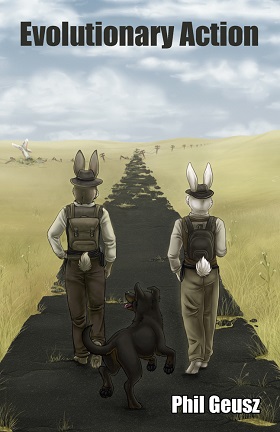Evolutionary Action
Author: Phil Geusz
Publisher: FurPlanet Publications
ISBN-10: 1-6145-0150-5
ISBN-13: 978-1-6145-0150-3
Disclosure: A free copy of this book was furnished by the publisher for review, but providing a copy did not guarantee a review. This information is provided per the regulations of the Federal Trade Commission.
This unusual science fiction novel, published in September 2013, is set in an unspecified future around the end of the 21st century. The protagonist, Dr. Rusty Harrison, is a genetically engineered rabbit-man, looking roughly like a realistic brown-furred Bugs Bunny. Scientists had just “genengineered” rabbit-people, designed to be totally pacifistic, when an unknown super-plague exterminates 99+% of humanity. Only the rabbit-people are immune.
The few survivors of humanity still outnumber the rabbit-people, but not by much. They try to keep civilization running, but there are not enough to keep the United States of America together. It has broken apart into many tiny independent state-based countries like the West Coast Confederation, the Sooner Republic, the Colorado Republic, Iowssouri, the Arkansas Free State, the Lone Star Republic and so on. Most of them are friendly and trying to maintain good relations with each other, but at least one is out for a brutal war of conquest against the others, executing the governments of the conquered states.
The University that was experimenting with genengineering before the Breakdown, has all of the intelligent Rabbits left in the world. It is one of the remaining practitioners of research; a politically independent enclave located in the Sooner Republic, which supports it. However, the armies of one of the aggressors are approaching the Sooners and neighboring Texas, and both the Sooner and Lone Star governments and the University administration are wondering what to do.
The problem is magnified by the fact that the Rabbits are designed to be pacifists. In fact, they are almost militantly pacifistic, if that is not a contradiction in terms. They believe in non-violence to the point of refusing to defend themselves even when confronted by human killers. Rusty is an anomaly; a Rabbit in whom the artificial non-violent instinct has not taken. He will defend himself, and as a result, most of the other Rabbits look down upon him.
Rusty is the only Rabbit that the University can send out on information-gathering missions and expect to come home alive. Both the University administration and the Lone Star government want him to find them allies, but they are undercut by the prevailing mood among the Rabbits being against self-defense. They are hardwired to believe that any form of aggression is evil. They refuse to help the Texan defense. Rusty is torn between wanting to be accepted by his fellow Rabbits, and exasperated by their blindness. If they won’t learn to defend themselves, they won’t exist once the first aggressor gets as far as the University grounds.
The novel is much more complex than this. There is what Rusty discovers on his explorations. There is the expanding picture of post-Collapse America. There is the mystery of who is trying to kill Rusty, and why. Why are most humans pathetically eager to meet a Rabbit, but someone important enough to hire killers wants Rusty dead? There is the mystery of what caused the Collapse, and whether it is pertinent to Rusty’s missions.
Despite’s Rusty’s attempts to be as peaceful and diplomatic as possible among human allies and friendly neutrals, there are shootings, poisonings, spyings, boobytrappings, interfering bureaucrats, and a Rabbit assistant whose help he needs but who despises him as a psychotic warmonger. One thing leads to another, and they all lead toward an apparent suicide mission deep into the heart of enemy territory. There may be one way out, but Rusty hesitates to take it …
Adults should enjoy “Evolutionary Action”, although it seems designed as a boys’ Young Adult novel by its mostly offstage violence and its lack of female characters. It comes as a 187-page trade paperback for $9.95, or a $2.99 Kindle e-book.






